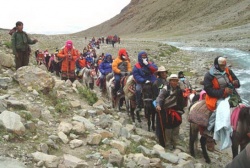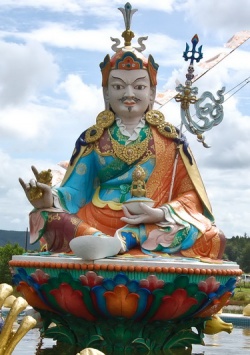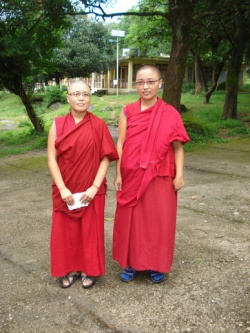Pilgrimage
Pilgrimage (cetiyacārikā or vandanācārikā) is the act of travelling to a place of religious significance for specifically religious reasons. In Buddhism, pilgrimage is neither an obligation as in Islam nor a penance as in Christianity, although it has long been and remains even today a popular practice.
The Buddha recommended that his disciples visit at least once in their lives the places where the four most important events in his life took place – Lumbinī where he was born, Bodh Gayā where he was enlightened, Sārnāth where he first proclaimed the Dhamma and Kusinārā where he passed away (D.II,141). However, while going on pilgrimage is good, being virtuous is far more important.
The Jātakamālā says: ‘More beautiful than any garland, sweeter than any taste, truthfulness generates great good and is less arduous than practising austerity or pilgrimage to far-off shrines.’
The first person we know of to have gone on pilgrimage was King Aśoka who went to Bodh Gayā in about 260 BCE and to Lumbinī some ten years later.
The most famous travel book of all time and one that has been continually in print for 14 centuries was written by the Chinese pilgrim Hiuen Tsiang.
This Buddhist monk spent 16 years on pilgrimage in India and later wrote an account of his journey which is filled with such detailed and accurate information that it continues to be studied by historians, geographers and travellers in India even today.
A pilgrimage is a journey or search of Moral or Spiritual significance. Typically, it is a journey to a shrine or other location of importance to a person's beliefs and Faith, although sometimes it can be a metaphorical journey into someone's own beliefs.
Many religions attach Spiritual importance to particular places: the place of birth or Death of founders or saints, or to the place of their "calling" or Spiritual Awakening, or of their connection (visual or verbal) with the divine, to locations where miracles were performed or witnessed, or locations where a deity is said to live or be "housed,"
or any site that is seen to have special Spiritual powers.
Such sites may be commemorated with shrines or temples that devotees are encouraged to visit for their own Spiritual benefit: to be healed or have questions answered or to achieve some other Spiritual benefit.
A person who makes such a journey is called a pilgrim.
As a common human experience, pilgrimage has been proposed as a Jungian archetype by Wallace Clift and Jean Dalby Clift.
The Holy Land acts as a focal point for the pilgrimages of the Abrahamic religions of Judaism, Christianity, and Islam.
According to a Stockholm University study in 2011, these pilgrims visit the Holy Land to touch and see physical manifestations of their Faith, confirm their beliefs in the holy context with collective excitation, and connect personally to the Holy Land.
In the early 21st century the numbers of people of all faiths making pilgrimages has continued to rise, with 39 of the most popular sites alone receiving an estimated 200 million visitors every year.
There is a growing awareness within the major Faith organisations that fulfilling the Spiritual obligations of pilgrimage may paradoxically conflict with the Spiritual obligation to care for the natural World.
In response to these concerns a global Green Pilgrimage Network was inaugurated in 2011, with municipal and religious authorities from Baha'ist, Buddhist, Christian, Daoist,
Islamic, Jewish, Shinto and Sikh sacred sites committing to the shared goal of minimising the environmental impact of pilgrims and, ultimately, achieving a 'positive footprint' for pilgrimage.
In 2012 an India Chapter of the Green Pilgrimage Network was launched, with a further ten Buddhist, Hindu, Islamic and Sikh pilgrimage sites from across India.
There are four places that Buddhists make pilgrimage to:
Lumbini: Buddha's birthplace (in Nepal)
Bodh Gaya: place of Enlightenment
Sarnath: where he delivered his first teaching
Kusinara: (now Kusinagar, India) where he attained mahaparinirvana (died).
Other pilgrimage places in India and Nepal connected to The Life of Gautama Buddha are:
Savatthi,
Pataliputta,
Nalanda,
Gaya,
Vesali,
Sankasia,
Kapilavastu,
Kosambi,
Rajagaha,
Varanasi,
Sabari Mala.
Other famous places for Buddhist pilgrimage include:
India: Sanchi, Ellora, Ajanta.
Thailand: Sukhothai, Ayutthaya, Wat Phra Kaew, Wat Doi Suthep.
Tibet: Lhasa (traditional home of the Dalai Lama), Mt Kailash, Lake Nam-tso.
Cambodia: Angkor Wat, Silver Pagoda.
Sri Lanka: Polonnaruwa, Temple of the Tooth (Kandy), Anuradhapura.
Laos: Luang Prabang.
Myanmar: Bagan, Sagaing Hill.
Nepal: Bodhnath, Swayambhunath.
Indonesia: Borobudur.
China: Yung-kang, Lung-men Caves. The Four Sacred mountains
Japan: Kansai Kannon Pilgrimage, Chūgoku 33 Kannon Pilgrimage, Shikoku Pilgrimage, Mount Kōya.





